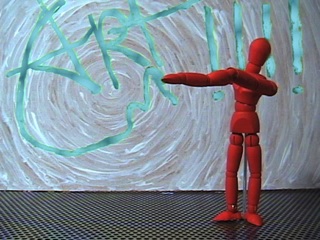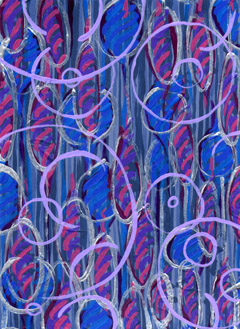July 2009 archives
you are here [x]: Scarlet Star Studios > the Scarlet Letters > July 2009
<< before
June 2009
after >>
August 2009
July 30, 2009
essay: stopmo webcomics
by sven at 10:40 pm
What if you created stopmo clips as if you were producing content for a webcomic?
Imagine: an ongoing series of 10-20 second clips that get published once a week… Some are stand-alone gags -- but others are part of large, dramatic story arcs broken into bite-sized episodes. Keeping a strict update schedule is critical, and somewhat stressful… Yet, the pay-off is a loyal audience that builds watching your show into their personal weekly rituals.
For about the past month, I've been really excited about this idea. Here I'm going into "deep thought" mode to flesh out the details.
1. ROLE MODELS
Amongst stopmoes, there are several popular role models. The Neo-Harryhausians (as I think of them) idolize "Uncle Ray" and yearn for the return of photorealistic stopmo monsters to feature films. Another group takes their inspiration from Tim Burton's Nightmare Before Christmas and Corpse Bride -- as is often apparent from the Gothic/German Expressionist influences in their character/set designs. Yet another group longs to follow in the footsteps of Will Vinton, fondly recalling the heyday of the California Raisins.
Whether the role model is Ray Harryhausen, Tim Burton, or Will Vinton, the career path that most stopmoes fantasize concludes with the publication of a feature-length film. The route to this goal is either a slow accrual of victories in the film festival circuit, ultimately leading to a deal with a big investor -- or the founding of one's own boutique studio, capable of taking on a multi-year project.
Lately, though, I've been looking to a different set of artists for inspiration.
I've become a loyal reader of several webcomics: Jeph Jacques' Questionable Content, Richard Stevens III's Diesel Sweeties, Randall Munroe's XKCD, Rene Ergstrom's Anders Loves Maria, Danielle Corsetto's Girls With Slingshots, to name a few. I've devoured the (live action) webisodes of Felicia Day's The Guild and Joss Whedon's Dr. Horrible's Sing-Along Blog. I've eagerly awaited new webtoon episodes of Amy Winfrey's Making Fiends (and now Squid and Frog) and lost afternoons to Mike Chapman and Craig Zobel's flash cartoon Homestar Runner.
What do these artists' webcomics, webisodes, and webtoons have in common? They're all presenting story worlds in an episodic format, using the internet as their primary distribution media… And what's more, they're all independent artists that publish according to their own time-tables, maintain absolute creative control of their content, and earn a living from their publications.
Sounds appealing! So, while I still admire the works of Ray Harryhausen, Tim Burton, and Will Vinton, I think it is these others that I want to be studying as I devise my potential career path.
2. WEBCOMIC BUSINESS MODEL
Surveying webcomics, webisodes, and webtoons, I think that the clearest business model has emerged among the folks doing comics…
Actually, there are really two business models among webcomics: "fee-to-see" or "free-to-see." With fee-to-see, there's either a tip jar (honor system) -- or you get a free sample and then pay a subscription to get into the archives. With free-to-see, the archives are all available -- profits come from selling ads and selling merchandise. Among the folks I've been reading, fee-to-see has been roundly rejected (e.g. How to Make Webcomics by Kurtz, Straub, Kellett, & Guigar; Jeph Jacques' post titled comics comics comics)…
So I'm identifying the webcomic business model with publishing high-quality free-to-see content that attracts an audience, then selling ads and selling merch to make a profit.
Contrast this with how people in film culture (hope to) make their money. Feature films in the cineplex or at art house theaters are fee-to-see. You have to fill seats in order to make your investment back -- which necessitates a big promotional campaign of posters, TV ads, etc. If you're aiming at placing your film on TV, then it's essentially the broadcaster who's paying the fee-to-see -- or more properly in their case, fee-to-play.
And if you're not at a point in your career where you can get mass-market distributors to buy your content? Well, you can try to win award money in the festival circuit -- but you're pretty much back to selling merch -- your DVDs… Either setting up a table at the festivals, or by word-of-mouth / internet publicity.
Some filmmakers are thinking about how they can further monetize their pet projects by selling non-DVD merch… T-shirts, toys, and stickers derived from their films. However, I believe they're unlikely to create significant revenue streams through these efforts.
Why? It works for the webcomics, right?
Well, see the problem is that most filmmakers' shows are one-offs. The films may make a big splash the first time an audience sees them… But then the film is forgotten by the next day. An integral part of what makes webcomics' merch business feasible is that they're releasing new content daily, weekly, or monthly -- not just every few years. The frequency of release is what allows brand loyalty to develop, which is what really drives purchases.
3. RELEASE SCHEDULE, LENGTH, EPISODIC STRUCTURE
Obviously you can't hope to put out feature-length stopmo films on a weekly basis. If you choose to increase the frequency of your releases, then the nature of your creations must also change.
I want to discuss how three interrelated issues will shape the form of your art: (a) release schedule, (b) length, (c) episodic structure.
Webcomics tend to update either daily or on something like a M-W-Fr schedule. Webtoons can get away with updating monthly; some flash cartoons manage to update weekly.
The longer the wait between new releases, the longer the clips you can create. However, the longer the wait for new releases, the more you lose your audience's attention. So, while there's an impulse to cram as much story as possible into each installment, personally I want to push myself to think in the opposite direction: What is the shortest video clip I can produce that still conveys a meaningful unit of comedy / drama?
Personally, I think that you could get away with publishing only 10-15 seconds of footage per week. If you have dialogue, that's just enough time to have Character A speak, Character B respond, and Character A react.
As an experiment, try taking a standard newspaper comic strip, 3-4 panels long, and read it aloud… 10-15 seconds is my best estimate. …The 3-4 panel comic strip is also a good comparison because each of those panels is the equivalent of a storyboard panel -- in which case, it seems you're looking to create episodes that are about 4 storyboard panels in length.
[Of course, if you want to publish on a monthly schedule -- 4 weeks worth of work -- you could probably get through 16 storyboard panels, and shoot about 60 seconds worth of footage.]
Won't working in such tiny segments cripple your ability to tell a story? …Not necessarily.
Once you commit to putting on a once-a-week show, you realize that there are two categories of episode: stand-alones, and serials. For stand-alones, think of "Garfield." When you read one episode of Garfield, you generally don't need to know anything about what came before, and aren't left wondering about what will come after. For serials, think of "Dick Tracy" or the old "Buck Rogers" cartoons. There's a storyline that carries on from week to week, which has continuity.
So here's something I'm interested in experimenting with… Take a graphic novel -- like Maus, Watchmen, or Persepolis -- and try to chop it down into smaller segments. Can you take a long-form script and figure out how to present it in three or four lines of dialogue at a time?
It seems likely that through the process of presenting stories in such short segments, the way in which you communicate will change. But this is nothing new… Look at how storytelling for television adapted to fit the needs of the medium: instead of presenting entertainment for a continuous hour, there are several mini-climaxes to help the audience bridge the commercial breaks. In my opinion, storytelling always adapts itself to the medium.
Stopmoes are familiar with feature-length films and short films… What I'm discussing here would perhaps best be termed "micro" length. "Epic" feature-length films are generally felt to be superior to short films, due to scope and grandeur… But I am of the opinion that a long-running serial of micro-length films could equal the emotional weight of a feature -- and even has some advantages over it, production-wise.
First off, when I think about the stories that I personally love most, they're all serials. Star Trek, Battlestar Galactica, Buffy the Vampire Slayer, Angel, Firefly, The X-Files… Frankly, a 13 or 26 hour season of TV shows is able to give me a richer world than a 90-120 minute film -- no matter how big the explosions!
Secondly, from the perspective of being an indie filmmaker, I find the long breaks between having completed films to show extremely demoralizing. The more often I'm able to put out a film, the more legitimate I feel as an artist -- and the less isolated I feel, off in my story universe. The sense of pride in completing small films frequently, and being able to show them to friends, family, and the world -- I find these aspects of micro-length work very attractive.
4. LIVE SHOW ETHOS & PRACTICALITIES OF RUNNING A WEEKLY SHOW
When you spend years working on a single film, the deadline for completion ceases to matter very much. You want to make the film exactly right, because you take pride in your craftsmanship. The final product of your effort is a DVD, an object, a unit of property to sell.
When you work on a weekly show, I believe the experience is a lot more like doing live theater. You've told everyone that there will be a show Friday night -- so ready or not, when the curtain rises "the show must go on." If you have to cut corners or improvise, you do what you have to do… The fact that you get up on the stage try to be entertaining is more important than whether or not you feel ready. And if you flop? Well, there's always next week.
It seems to me that if you commit to putting on a weekly stopmo show, the following guidelines will be helpful:
- Use what you've already got. Fabrication is time-expensive, and time is what you don't have!
- If you have a set or a character, re-use it multiple times. There are plenty of story possibilities in those elements -- exhaust them.
- Keep a library of sets and puppets. Once you have an asset, don't throw it away!
- New sets and puppets will be added to the library piecemeal. You'll be very lucky if you are able to add one new puppet or one new set each week. To do so adds at least a full day's labor.
- Plan puppets/sets to be multi-use. Until you have the resources to start off an ongoing show with multiple elements, try to make elements that could be used together in different ways. Scale and aesthetic play into this thought process.
Think about the Muppet Show as an example. Once you have the "Pigs in Space" set and puppets, you can do a skit that uses these assets once every episode. The audience doesn't get bored of such recycling -- rather, it becomes something familiar to look forward to.
I mentioned earlier that there are two types of segment that you can do using the episodic structure: stand-alones and serials. It strikes me that so long as you have a weekly schedule, there's no reason why you have to choose one or the other. You can start off doing stand-alone clips, then sprinkle in installments of larger story arcs as you finish fabricating the necessary sets and puppets. Recycling old puppets and sets in new skits buys you more time to fabricate bigger worlds -- so there's no dead time in the performance schedule while you're preparing something more ambitious.
5. FILM CULTURE VS. COMIC CULTURE
It seems to me that most stopmoes want to be a part of film culture. By "film culture," I mean that the community of filmmakers and film-lovers meet together annually in gatherings across the country known as film festivals. Often there's not as much interaction between the filmmakers and audience members as we might like -- but often enough there are panel discussions, vendor areas, and good conversations in the lobby. Like Brigadoon, the magic city that appears only for a day once each year, the film culture manifests through such events.
Webcomic artists, on the other hand, have a separate culture. Webcomic and print-comic artists alike gather at comic conventions… The biggest and most famous of which is the San Diego Comic-Con. I ask myself: could a stopmo doing a weekly micro-length show fit in in the vendor areas of such cons? My answer: heck, yeah!
Things that a weekly stopmo show has in common with your typical webcomic: a cast of fictional characters, a primarily visual medium, episodic story structure, geek appeal… While not without some controversy, notice how the San Diego Comic-Con has grown to encompass films and toys as much (or more than) comics. It seems that the con is really about fictional universes… And the characters leap effortlessly between media -- from novels to comicbooks to films to toys.
The only firm difference I find between webcomics and stopmo webtoons is that you can't read a film -- you have to watch it. Technologically, you need a player of some sort. But even so, you could make an academically sound argument that stopmo is just another form of "sequential art" (to use Scott McCloud's term)… You're just viewing animated comics at 24 panels per second!
So: I think that a stopmoe could embrace the identity of "webcomic" or "webtoonist" and fit in just fine in the comic convention culture… But would film culture have them back again if they did?
Micro-length films might be compiled into a longer film to show at festivals… But I have my doubts about how well the compilation would flow. If the film clips weren't made to be shown as a continuous series, translating them for the big screen is likely to be clumsy.
What's more, many of the prestigious film festivals do not accept submissions that have been shown in public previously -- which would automatically disqualify stopmo webcomics/webtoons. Yet, if you were willing to sacrifice the competitive fests, you could still take your works to other fests… Which would then allow you to sell DVDs in the vendor's area, if nothing else.
PARTING THOUGHTS: A VIABLE ALTERNATIVE
The stopmoe community has wrestled with the question of how much of one's content should go online. One side in the debate has argued forcefully that it's a mistake to just give your work away online, without any hope of making back your investment. Particularly if you think you can get into film fests, then you should keep your work offline and keep it secret.
Having explored the webcomic model of publishing a fair bit now, I think that there is a way to make a fair profit from putting your films online -- but the nature of the films has to change considerably for the magic to work. What's important is to post your content with maximum frequency… Which in turn necessitates micro-length, and then propels you toward telling stories using episodic structure.
I'm not personally at a point where I'm ready to commit to doing a weekly show -- but I think it's very exciting to identify a viable alternative to the filmmaking role models and business models we're familiar with.
posted by sven | permalink | categories: stopmo, writing
July 29, 2009
birthday card: linda womack
by sven at 7:00 am

Today is Linda's birthday...
From Sven & Gretchin: happy birthday Linda!
posted by sven | permalink | categories: painting
July 27, 2009
ichbonnsen on muglorp
by sven at 4:30 am

Guess who…!
posted by sven | permalink | categories: bestiary, stopmo
July 20, 2009
art buddy invitational
by sven at 7:00 am

A while back, our friend Dayna Collins (Alley Art Studio) initiated an "Art Buddy Invitational." She sent out these little artist's manikins to friends, and asked that we do something creative with them.
It only seemed natural that I ought to do some animation with my Art Buddy.
My animation table's been gathering dust far too long. Scripting, machining, sculpting, doing X-sheets… It's too easy to get bogged down. So: What a treat be doing a little improv again!
Thanks for the jump start, Dayna!
posted by sven | permalink | categories: exhibits & events, stopmo
July 4, 2009
birthday card: shield bonnichsen
by sven at 7:00 am

Today is my brother's birthday...
From Sven & Gretchin: happy birthday Shield!
posted by sven | permalink | categories: painting
July 2, 2009
birthday card: todd lisonbee
by sven at 7:00 am

Today is Todd's birthday...
From Sven & Gretchin: happy birthday Todd!